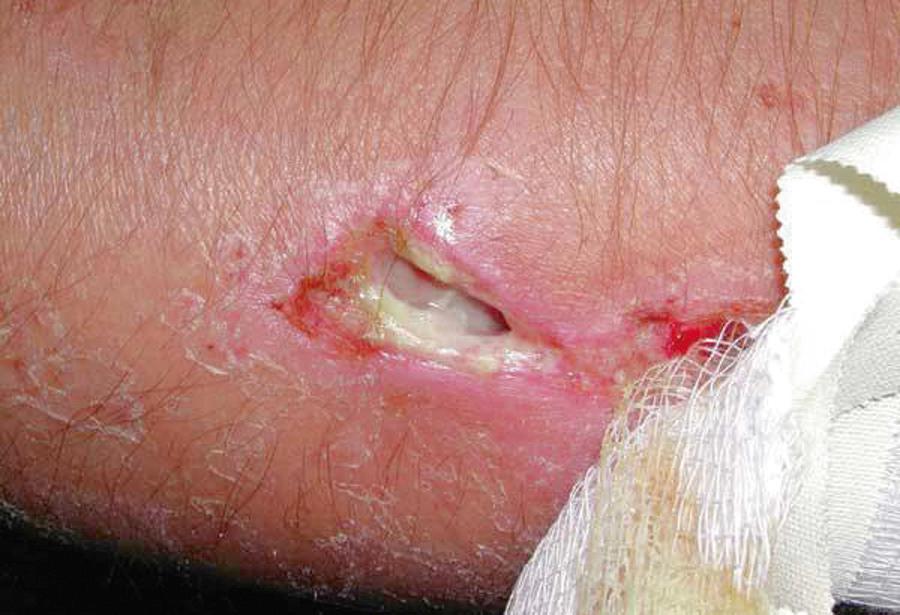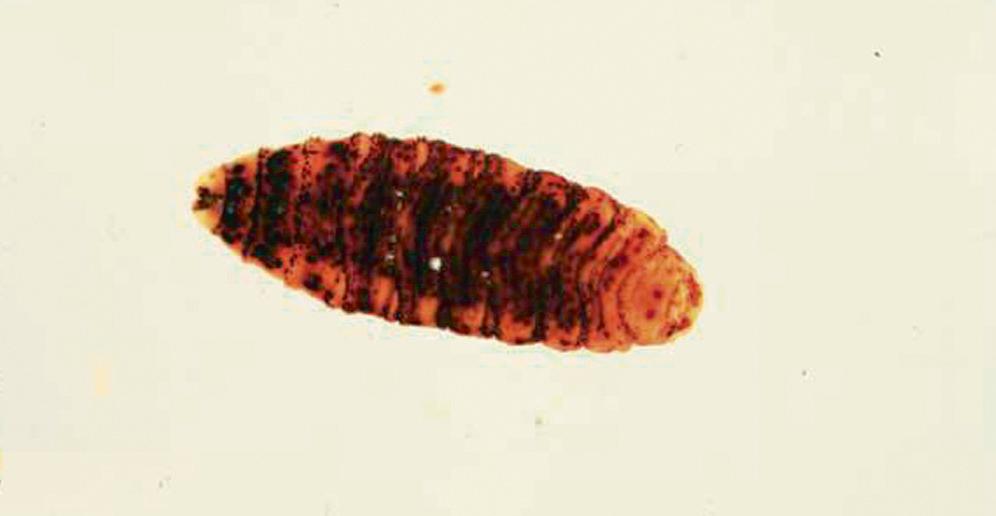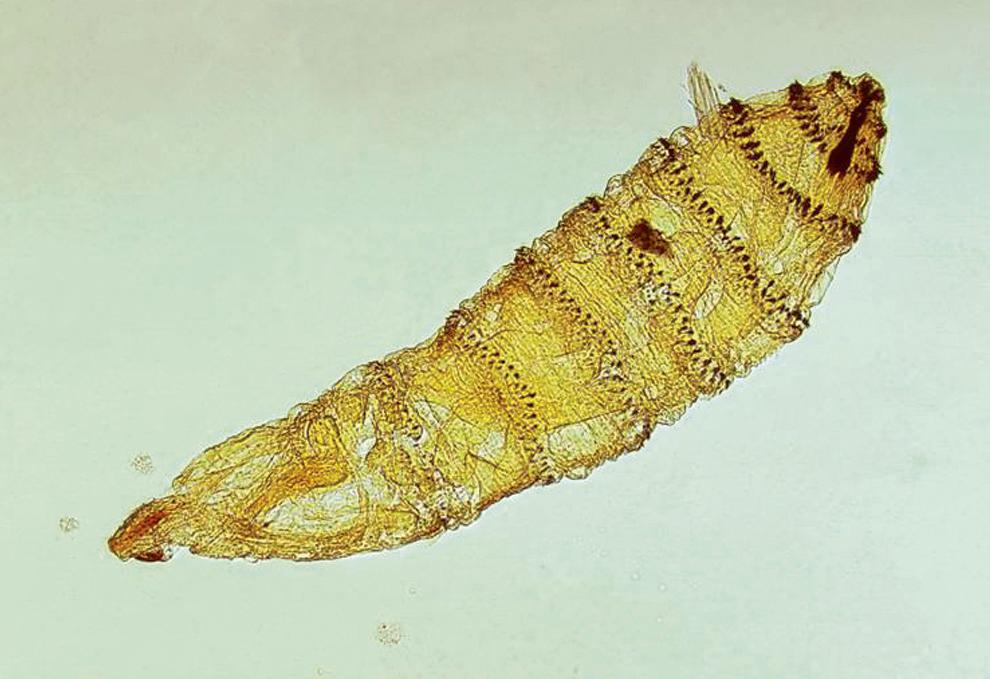Physical Address
304 North Cardinal St.
Dorchester Center, MA 02124
Flies and fleas are mostly bothersome biting nuisances of humans and animals that can also transmit infectious diseases and deeply invade living tissues, causing amputation, disfigurement, and, rarely, death. Flies can serve as mechanical vectors of shigellosis, and rat fleas can transmit bubonic plague and murine typhus. Flies may lay their eggs on human flesh, and their developing larvae, or maggots, can invade subcutaneous tissues and penetrate external body cavities, such as the orbits, ears, and nares. Flea larvae can also burrow into subcutaneous tissues to feed, complete their developmental stages or instars, and promote secondary infections with incapacitating sequelae, including autoamputation of toes and fingers, especially in impoverished tropical communities plagued by endemic jigger fleas (Tunga penetrans).
Myiasis is an ectoparasitic infestation of viable or necrotic tissues by the dipterous larvae of higher flies and may be broadly classified as obligatory or facultative myiasis. In obligatory myiasis, maggots must live and feed on human or animal hosts as part of their life cycle. In facultative myiasis, normally free-living maggots that preferentially feed on carrion and decaying matter attack and feed on the necrotic sores and wounds of living human and animal hosts. Maggot therapy with blowfly larvae is still used today to débride necrotic wounds.
Myiasis may be further stratified clinically as furuncular (subcutaneous) myiasis, wound (superficial cutaneous) myiasis, cavitary (atrial or invasive) myiasis, intestinal myiasis, urinary myiasis, and vaginal myiasis. Furuncular myiasis is the most common clinical manifestation of myiasis and occurs when one or more larvae penetrate the skin, causing pustular lesions that resemble boils or furuncles. Larval maggots can also infest external orifices, sores, or open wounds, causing cavitary and wound myiasis. Cavitary myiasis is usually caused by screwworm larvae that can penetrate festering wounds or invade the orbits, nostrils, or external ear canals ( Figs. 294.1 and 294.2 ). Intestinal myiasis is uncommon, usually caused by the accidental ingestion of maggot-contaminated food, and characterized by self-limited nausea, vomiting, and diarrhea. Genitourinary myiasis is also uncommon and may present as dysuria, hematuria, and pyuria, after larval invasion of the urethra (urinary myiasis) or vagina (vaginal myiasis).


Although there are many families of dipterous flies (order Diptera), flies from three families cause most human and animal myiasis: Oestridae, or botflies; Calliphoridae, screwworms and blowflies; and Sarcophagidae, carrion-feeding flies. The most common myiasis-causing fly species are classified taxonomically and stratified by clinical type of myiasis infestation in Table 294.1 .
| FAMILY (COMMON FAMILY NAME) | TAXONOMIC CLASSIFICATION | COMMON NAME | GEOGRAPHIC DISTRIBUTION | TYPE OF MYIASIS INFESTATION |
|---|---|---|---|---|
| Oestridae (botflies) | Dermatobia hominis | New World botfly | Caribbean, Central and South America | Furuncular |
| Cuterebra spp. | Rodent and rabbit botflies | North America, northern Central America | Furuncular | |
| Hypoderma sinense | Indian botfly | India | Furuncular | |
| Calliphoridae (screwworm flies, blowflies) | Cordylobia anthropophaga | Tumbu fly | Africa | Furuncular |
| Cordylobia rodhaini | Lund fly | Africa | Furuncular | |
| Auchmeromyia senegalensis | Congo floor mat fly | Africa | Superficial cutaneous (no tissue invasion) | |
| Cochliomyia hominivorax | New World screwworm | Southern North America, Central and South America | Wound, cavitary | |
| Chrysomyia bezziana | Wound, cavitary | |||
| Lucilia spp. | Old World screwworm | Africa, Asia | Wound, cavitary | |
| Calliphora spp. | Greenbottle blowflies | Worldwide | Wound (used for maggot therapy) | |
| Bluebottle blowflies | Worldwide | Wound (used for maggot therapy) | ||
| Sarcophagidae (carrion flies) | Sarcophaga carnaria | Africa | Wound, cavitary, gastrointestinal | |
| Wohlfahrtia magnifica | Africa | Wound, cavitary, gastrointestinal |
In a retrospective epidemiologic study in Rio de Janeiro, Marquez and colleagues described 71 patients with furuncular and cavitary myiasis during the period 1999–2003. Myiasis was more prevalent among adults older than 51 years (42%) and children younger than 10 years (34%). Most of the population was male (61%) and impoverished (62%). The predominant causative agent of furuncular myiasis was Dermatobia hominis, the New World human botfly, and the predominant causative agent of cavitary myiasis was Cochliomyia macellaria, an indigenous species of New World screwworm. The authors concluded that myiasis is an opportunistic infestation of disadvantaged vulnerable populations living in nonhygienic conditions. In a similar retrospective collective analysis, Jiang described 54 cases of human myiasis in China from 1995–2001. Although the Chinese cases were equally distributed between genders, most cases occurred in infants and children (72%) and were described as either hypodermic-invasive ( n = 31) or ocular ( n = 12). In another collective review, Schwartz and Gur reported 12 cases of furuncular myiasis caused by D. hominis, the human botfly, in 12 Israeli travelers returning from four South American countries in the Amazon Basin. Clyti and coworkers described an epidemic of human botfly furuncular myiasis in 30 patients living in coastal urban communities of French Guiana between January and March 2000 after heavy rainfall that accelerated soil maturation of pupae into adults.
Tamir and associates reported two cases of furuncular myiasis caused by Cordylobia rodhaini, the Lund fly, in Israeli travelers returning from Ghana. In addition to D. hominis and Cordylobia spp., Cuterebra spp. of botflies can also cause furuncular myiasis in North America and throughout Africa and Asia ( Fig. 294.3 ). Shorter and coworkers reported two cases of Cuterebra spp. botfly-induced furuncular myiasis in children in New England (see Fig. 294.3 ). Cuterebra or rabbit botflies are endemic in the northeastern United States and southeastern Canada, where they have established a zoonotic reservoir in lagomorphs (rabbits and hares) and cause periodic cluster outbreaks of furuncular myiasis in domestic animals and humans.

Although dermatoses are among the leading medical complaints in returning travelers, myiasis and tungiasis remain among the least frequently diagnosed dermatologic conditions. However, recently reported case series of myiasis and tungiasis in returning travelers have provided new epidemiologic analyses of the frequencies, distributions, and risk factors for these infections. In a retrospective observational study of 90 returning Israeli travelers with myiasis over the reporting period 1999–2014, most cases were caused by D. hominis and acquired in Latin America ( n = 72, 80%), and fewer cases were caused by Cordylobia spp. and acquired in Africa ( n = 18, 20%). Manual extraction was sufficient to remove the embedded larvae in most cases (76%), with fewer cases (24%) requiring surgical extraction. Most patients did not receive antibiotic prophylaxis, and only one patient developed a secondary infection after partial removal of the larva. The authors concluded that myiasis is not a rare dermatoses in returning travelers, with most cases acquired in Latin America not Africa, and treatment should include full larval extraction without antibiotic prophylaxis.
In an outbreak of tungiasis in 13 travelers returning from Madagascar, walking barefoot (100% of cases) and/or wearing open sandals (62% of cases) were the highest risk factors for tungiasis, with a mean clinical incubation period of 15 days or longer than observed in prior case series (7–12 days). Observations such as these in returning travelers have provided clinicians with a better understanding of the causes, clinical incubation periods, and treatments of these infections, which are less rare than generally suspected.
The most common forms of human myiasis worldwide are furuncular myiasis and cavitary (invasive) myiasis. Furuncular myiasis is most often caused by subcutaneous larval invasion by the tumbu fly, Cordylobia anthropophaga, in Africa, and the New World human botfly, D. hominis, in the subtropical and tropical areas of the Americas (see Table 294.1 ). Cavitary myiasis is usually caused by zoonotic screwworm larval deposition in open wounds or external orifices, such as the nares, ears, and orbits, and may be characterized by deep tissue larval invasion, with secondary infection and extensive tissue necrosis. Cochliomyia hominivorax, the New World screwworm, is a common cause of cavitary myiasis in the Americas, and Chrysomyia bezziana, the Old World screwworm, is a common cause of cavitary myiasis in Africa, Asia, and Indonesia. Cavitary myiasis must be managed aggressively with surgical débridement and antibiotic therapy for secondary infections to limit tissue damage and disfigurement (see Figs. 294.1 and 294.2 ).
Although the clinical manifestations, treatments, and prevention strategies are similar in furuncular myiasis, the mechanisms of larval fly invasion are often different. The gravid female tumbu fly deposits its eggs on moist sandy soil or on wet clothing (e.g., cloth diapers) hung outside to dry. When the human victim dons egg-infested clothing, larvae emerge and rapidly burrow into the skin with sharp mandibles for further development. On the other hand, the female botfly captures blood-feeding insects, usually mosquitoes, in midflight and attaches her eggs to the undersurface of the insect. The intermediate biting vector then delivers the botfly eggs to its blood meal victims, where the eggs hatch immediately and release their larvae to feed on warm-blooded hosts. Human botfly larvae then rapidly burrow into the skin with sharp mandibles to begin their developmental instar stages, which can last 6 to 12 weeks.
In addition to travel history in endemic regions, the mechanisms of larval fly invasion assist in differentiating the cause of furuncular myiasis. In tumbu fly ( C. anthropophaga) myiasis, lesions are usually located on body regions covered by clothing, such as the buttocks and trunk. In New World human botfly (D. hominis) myiasis, lesions are usually located on exposed areas, such as the scalp, face, and extremities.
After completing three instar stages, the final larval forms of the tumbu fly and human botfly wriggle out of their draining, boil-like, 1- to 2-cm furuncular swellings; drop to the ground; and pupate in warm, moist soil into adult flies within 9 to 14 days. Victims may recall a flying insect bite that preceded human botfly-induced furuncular myiasis. While developing in their furuncles, larvae are active, protrude intermittently through draining wounds, and maintain surface contact for respiration with their posterior, paired spiracles. Anterior hooklets anchor the maggots in place subcutaneously, making manual removal, even with forceps, difficult (see Fig. 294.3 ).
Become a Clinical Tree membership for Full access and enjoy Unlimited articles
If you are a member. Log in here